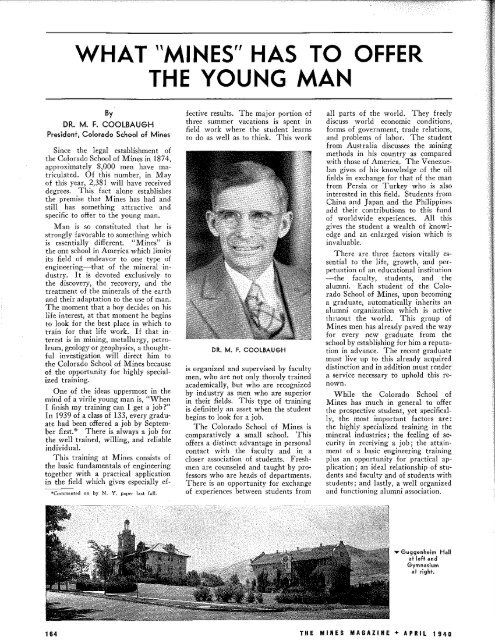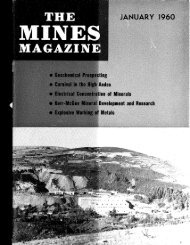A L U M N I N U M B C E L E B R A T I N G ... - Mines Magazine
A L U M N I N U M B C E L E B R A T I N G ... - Mines Magazine
A L U M N I N U M B C E L E B R A T I N G ... - Mines Magazine
Create successful ePaper yourself
Turn your PDF publications into a flip-book with our unique Google optimized e-Paper software.
W H A T "MINES" H A S T O OFFERByDR. M. F. COOLBAUGHPresident, Colorado School of <strong>Mines</strong>Since the legal estahlishment ofthe Colorado School of <strong>Mines</strong> in 1874,approximately 8,000 men have matriculated.Of this number, in Mayof this J'ear, 2,381 will have receiveddegrees. This fact alone establishesthe premise that <strong>Mines</strong> has had andstill has something attractive andspecific to offer to the young man.Man is so constituted that he isstrongly favorable to something whichis essentially different. "<strong>Mines</strong>" isthe one school in America which limitsits field of endeavor to one type ofengineering—^that of the mineral industry.It is devoted exclusively tothe discovery, the recovery, and thetreatment of the minerals of tbe earthand their adaptation to the use of man.The moment that a boy decides on hislife interest, at that moment he beginsto look for the best place in which totrain for that life work. If that interestis in mining, metallurgy, petroleum,geology or geophysics, a thoughtfulinvestigation will direct him tothe Colorado School of <strong>Mines</strong> becauseof the opportunity for highly specializedtraining.One of the ideas uppermost in themind of a virile young man is, "WhenI finish my training can I get a job?"In 1939 of a class of 133, every graduatebad been offered a job by Septemberfirst.* There is always a job forthe well trained, willing, and reliahleindividual.* Co mme 11 ted on by N. Y. paper last fall.THE Y O U N Gfective results. The major portion ofthree summer vacations is spent infield work where the student learnsto do as well as to think. This workDR. M. F. COOLBAUGHis organized and supervised by facultymen, who are not only thoroly trainedacademically, but who are recognizedby industry as men who are superiorin their fields. This type of trainingis definitely an asset when the studentbegins to look for a job.This training at <strong>Mines</strong> consists ofthe basic fundamentals of engineeringtogether with a practical applicationin the field which gives especially ef-The Colorado School of <strong>Mines</strong> iscomparatively a small school. Thisoffers a distinct advantage in personalcontact with the faculty and in acloser association of students. Freshmenare counseled and taught hy professorswho are heads of departments.There is an opportunity for exchangeof experiences between students fromM A Nall parts of the world. They freelydiscuss world economic conditions,forms of government, trade relations,and problems of labor. The studentfrom Australia discusses the miningmethods in his country as comparedwith those of America. The Venezuelangives of his knowledge of the oilfields in exchange for that of the manfrom Persia or Turkey who is alsointerested in this field. Students fromChina and Japan and the Philippinesadd their contributions to tbis fundof worldwide experiences. All thisgives the student a wealth of knowledgeand an enlarged vision which isinvaluable.There are three factors vitally essentialto the life, growth, and perpetuationof an educational institution—the faculty, students, and thealumni. Each student of the ColoradoSchool of <strong>Mines</strong>, upon becominga graduate, automatically inherits analumni organization which is activethruout the world. This group of<strong>Mines</strong> men has already paved the wayfor every new graduate from theschool by establishing for him a reputationin advance. The recent graduatemust live up to this already acquireddistinction and in addition must rendera service necessary to uphold this renown.While the Colorado School of<strong>Mines</strong> has much in general to offertbe prospective student, yet specifically,the most important factors are:the highly specialized training in themineral industries; the feeling of securityin receiving a job; the attainmentof a basic engineering trainingplus an opportunity for practical application;an ideal relationship of studentsand facult)' and of students withstudents; and lastly, a well organizedand functioning alumni association.164 THE MINES MAGAZINE * APRIL 1940ByJ. HARLAN JOHNSON, '23Associa+e Professor of Geology andCurator of the MuseumCoiorado School of <strong>Mines</strong><strong>Mines</strong> alumni and friends will bedelighted to know that the School hasreceived tbe famous Hoffman miningmurals which were painted for themining exhibit at the Golden Gate InnationalExposition of 1939. Theywere displayed in the Hall of Mineralsleading to the mining exhibit of TreasureMountain.The Artist*Born in Boston in 1901, Irwin D.Hoffman received bis training at theschool of tbe Museum of Fine Artsin that city. In 1924 he was awardedthe Page Traveling Scholarship, andfor the following two and a half yearstraveled and studied in various partsof Europe. Returning to this countryin 1927, he took a studio in New YorkCity, where at intervals he has exhibited.His interest in mining arose fromthe fact that both his brothers are miningengineers. With them he visitedmost of the mining camps in tbeUnited States and Canada, and severalin Mexico.Shortly after the discovery of thefamous Noranda mine in Quebec in1922, he spent the summer of 1924prospecting in this area and participatedin an old-timers' gold rush withplenty of excitement but not much*The statement about the artist an& the detaileddescriptions of the nuirals are taken' with very littleor no change from the well written article •MiningExhibits, Inc. secures the Hoffman Murals" publishedin the Western Mining News, February, 1939.The cuts used were courteously loaned to the <strong>Mines</strong><strong>Magazine</strong> by the Western Mining News, through theefforts of Frank Hayward, President of the Bay CitiesSection.-cotnTHE MINES MAGAZINE ^ APRIL 1940I .gold. However, the experience formedthe background of an interest whichhas been increasing with the years untiltoday his etchings, paintings andmurals of mining activities and menare winning for him sure and substantialrecognition.Unlike others who have attemptedmining subjects, Hoffman's work inaddition to an outstanding virility andartistry, is authentic in all its technicalmining aspects. His work soon cameto the attention of mining men, andas a direct result he was invited tobecome a member of the American Instituteof Mining and MetallurgicalEngineers in 1936. The secretary ofthe organization wrote as follows:"According to the published recordsof your training and position, you havethe qualifications for membership, andI herewith extend to you an invitationto apply."The MuralsThe murals are six in number andshow vividly various stages in the historyof mining.Panel IThis panel depicts the three earlystages in the development of mining{Fig. 1). In the upper left corner wesee a group of Piltdown miners workingstopes for flint. As far as we know,this is the earliest recorded miningoperation in tbe history of man (about50,000 to 125,000 years ago). AtObourg, in Belgium, a series of prehistoricunderground flint workingshave been discovered. These have beenfreely described by T. A. Rickard inhis notable work "Man and Metals".Their tools may he seen in the RoyalMuseum of Natural History in Brussels,Belgium.In the upper right section is shownthe beginning of the Iron Age. TheCave Man discovers that meteoriciron can be recovered and fabricatedinto implements by heating and forging.This was his only source of metalfor the thousands of years that precededthe discovery of copper and tin.In the lower half of the panel isshown the first smelting and castingoperations of primitive man and wefind ourselves in the Bronze Age. Thisperiod coincides with the last periodsof glaciation some 20,000 3'ears ago.The Cro-Magnon man representedhere was our real progenitor and resemblesus closely. He was about sixfeet tall and had a brain capacity fullyas great as ours. In the building ofhis fires he discovered that some of thestones with which he built his hearthwould melt and then congeal into aspongy substance that could be fashionedinto implements of variousshapes by pounding. His natural intelligencesoon led him to the discoverythat this substance, copper, could bemelted in a specially constructed furnaceand poured into moulds whichwere cut into stone, and in this wayhe discovered the principles of casting.Thus we see in the center of this panelthe primitive smelter, pumped to asmelting heat by the man with theblow torch and his companion pressingon primitive bellows which wereprobably made of the hides of animals.In the left foreground, is a sword beingtaken from the case, and hatchetsand spearheads are being poured. Theman in the lower right foregroundpounds his sword on an anvil to temperit to proper strength. Directly behindhim, we see the potter's wheel whichwas also developed by primitive manat about this time. Eventually belearned to use his potter's skill to constructmoulds for casting.165

















